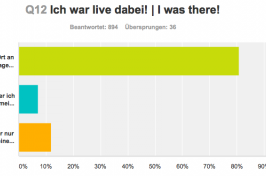Since 2015, the Deutsche Bahn railway company has been releasing data on its railway network and traffic to developers. In the "Work" track, Deutsche Bahn data analyst Jonas Westphal first presents the latest developments in his talk "Better Understanding Mobility and Data Thanks to Algorithms". Following him, Stefan Kaufmann from the Open Data Task Force reports on current projects in "Open Data in Public Transportation Networks – Lo and behold, it's moving!"
"Nowadays, you can track anything. It's shear data madness" said Jonas Westphal on Day 3 of the re:publica TEN. He raves about how packages and containers can be tracked from the sender to the recipient and how data bottlenecks for long-distance trains can be made visible in real-time on the web. In some cities, like Hamburg, there are even automatic bicycle counters.
Open Data activists like Stefan Kaufmann from the Open Data Task Force want to make this type of data available to the public – and use it for the good of all travellers. For example, the Bureau of Transportation Statistics in the United States already puts all airplane data online for any, or all, developers to access.
In the last years, individual transportation associations and, finally, the Deutsche Bahn took their data to the web. In the meantime, you can find data sets on station platforms, stops and even train station elevators, at the ready on their data.deutschebahn.com website.
"Local transport is like tap water" explained Stefan Kaufmann. "It should be made available to everyone, cheaply and in good quality." As an Open Data activist, he wants to find out which problems certain passengers have, and how these can be solved with the help of open data.
To be able to do this, the Deutsche Bahn initiated mindbox, a startup accelerator in Berlin which holds regular hackathons with open data and promotes startups. Usable app prototypes are presented here. They are the winners of the last competition with the DB Elevator API. One of the winners, the Indoorvator app, shows wheelchair users accessible areas at the Dresden train station.
A train radar from the Deutsche Bahn is also available in a Beta phase, in which users can follow trains on a map of Germany in real time. Travic is a similar real-time project with data from all over the world, where users can watch busses travelling around Manhattan.





